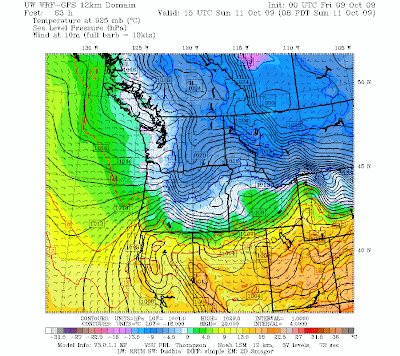
There is a great deal of interest and concern about flooding in the Green River valley. Before the construction of the Howard Hanson dam in 1962, that valley flooded regularly, which was of minor concern when it was predominantly agricultural. But the dam afforded protection for nearly all heavy rainfall events and allowed the development of the Valley, from Kent and Auburn to
Renton. Today, thevalley contains billions of dollars of warehouses, factories, stores, housing, and public infrastructure. The problem, of course, is that the Howard Hanson dam was damaged in the heavy precipitation of last January and the U.S. Army Corps of Engineers are worried about a catastrophic failure if the dam is filled. Currently, they only plan to fill the dam a maximum of 1/3 this winter. From my discussions with the Corps and others, it appears that they can prevent flooding for a 1-2 year return-time storm and perhaps a 5 year storm--anything more and flooding will probably result. Their public estimate has been a roughly 1 in 3 chance of flooding this year. This is also a very personal concern of mine...my son lives in an apartment only a few hundred feet from the river!
The National Weather Service and its parent organization--
NOAA--have been revving up to provide enhanced prediction of atmospheric and hydrological conditions. The
NWS will be placing 11 additional rain gauges in the Green River watershed. This is very useful--we need a better idea of how much rain has fallen, so we can run accurate hydrological simulations of river level and to evaluate and calibrate our atmospheric models.
But something else is going in and is the subject of considerable hype and misinformation--a
NOAA ESRL (Earth System Research Lab) Atmospheric River Observatory (see the picture above to see what the instruments look like). This lab has already made the front page of the Seattle Times and has been described in various local newspapers. Emergency managers and others have asked for more of them, at considerable public cost. But as I will describe below, they really won't help much and are not worth the expense.
Most of our local flooding events are associated with narrow plumes of warm, moist air coming out of the subtropics--known as atmospheric rivers or pineapple expresses in the literature. A view of the moisture stream associated with the Dec 07 event is shown below. Our computer forecast models are getting very good at predicting these events and the forecasts of most of the major events of the past several years have been quite accurate--but not perfect.

In order to provide more information about the flow coming off the Pacific,
NOAA ESRL has recently installed one of their Atmospheric River Observatory equipment suites at
Westport along the Washington coast. This system can measure the weather elements at the surface, as well as the winds, precipitation, temperature, and humidity IMMEDIATELY above the unit. This week the unit went operational and you can get to the information at this web site: http://www.esrl.noaa.gov/psd/data/obs/
A sample of today's output showing the height of the freezing level (black dots) is shown below. Now it is certainly nice to have this data for verifying our computer models, but it really is not very useful for forecasting. We already have a very good idea of the freezing level from the Seattle
profiler, aircraft ascents and descents into Seattle Tacoma Airport, and the local radiosonde (balloon-launched weather obs) that we have now. Besides when we have a flood-inducing atmospheric river event the air is inevitably so warm that we know that the whole Green River Watershed is in rain. In addition, the air is moving so fast during atmospheric river events that coastal air reaches the Cascades in about an hour or two. Finally, the data is only from a narrow pencil beam above
Westport--which does not give us the comprehensive view we really need. Image a cat scan that only shows the details beneath a single point--few doctors would use it.
In
contrast, the coastal radar we are getting in a few years due to the efforts of Senator
Cantwell and others in our state delegation will provide a wide ranging view over the entire region...including well offshore...that will be of great forecasting utility.

There are some well-meaning individuals (like the emergency manager mentioned in the Seattle Times article) who want the
NWS to secure one or two more AR observatories--at substantial public expense--to provide more "protection" and warning--and they propose to put them at or near the dam. But let me be honest--these will not help weather or hydrological prediction very much. They might be nice to have for research purposes, but won't assist the threatened folks of the Green River Valley.
Rather than spend large amounts of money on such equipment, it would be far better to expedite the coastal radar so its substantial capabilities are on line a year earlier. This year is an El Nino year which reduces the threat after the new year...next year could be a neutral year--when the worst flooding events tend to occur.






















































